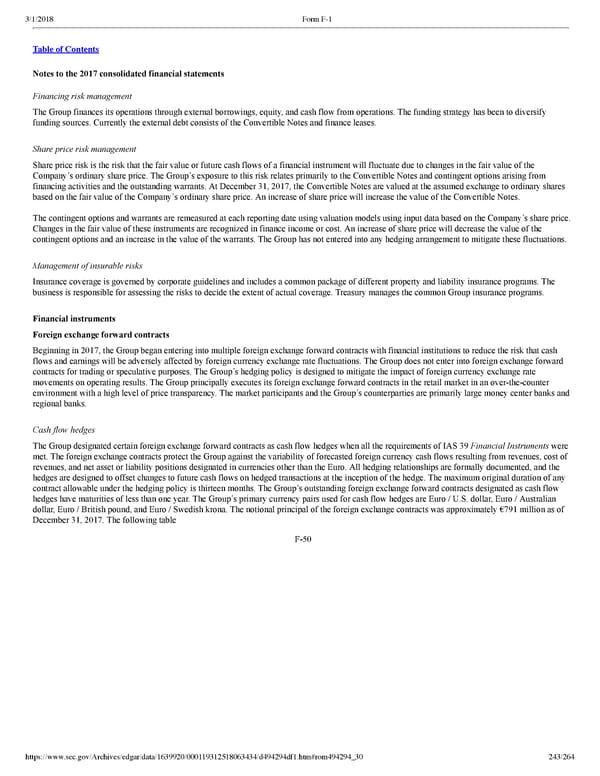243/264 Notes to the 2017 consolidated financial statements Financing risk management The Group finances its operations through external borrowings, equity, and cash flow from operations. The funding strategy has been to diversify funding sources. Currently the external debt consists of the Convertible Notes and finance leases. Share price risk management Share price risk is the risk that the fair value or future cash flows of a financial instrument will fluctuate due to changes in the fair value of the Company’s ordinary share price. The Group’s exposure to this risk relates primarily to the Convertible Notes and contingent options arising from financing activities and the outstanding warrants. At December 31, 2017, the Convertible Notes are valued at the assumed exchange to ordinary shares based on the fair value of the Company’s ordinary share price. An increase of share price will increase the value of the Convertible Notes. The contingent options and warrants are remeasured at each reporting date using valuation models using input data based on the Company’s share price. Changes in the fair value of these instruments are recognized in finance income or cost. An increase of share price will decrease the value of the contingent options and an increase in the value of the warrants. The Group has not entered into any hedging arrangement to mitigate these fluctuations. Management of insurable risks Insurance coverage is governed by corporate guidelines and includes a common package of different property and liability insurance programs. The business is responsible for assessing the risks to decide the extent of actual coverage. Treasury manages the common Group insurance programs. Financial instruments Foreign exchange forward contracts Beginning in 2017, the Group began entering into multiple foreign exchange forward contracts with financial institutions to reduce the risk that cash flows and earnings will be adversely affected by foreign currency exchange rate fluctuations. The Group does not enter into foreign exchange forward contracts for trading or speculative purposes. The Group’s hedging policy is designed to mitigate the impact of foreign currency exchange rate movements on operating results. The Group principally executes its foreign exchange forward contracts in the retail market in an overthecounter environment with a high level of price transparency. The market participants and the Group’s counterparties are primarily large money center banks and regional banks. Cash flow hedges The Group designated certain foreign exchange forward contracts as cash flow hedges when all the requirements of IAS 39 Financial Instruments were met. The foreign exchange contracts protect the Group against the variability of forecasted foreign currency cash flows resulting from revenues, cost of revenues, and net asset or liability positions designated in currencies other than the Euro. All hedging relationships are formally documented, and the hedges are designed to offset changes to future cash flows on hedged transactions at the inception of the hedge. The maximum original duration of any contract allowable under the hedging policy is thirteen months. The Group’s outstanding foreign exchange forward contracts designated as cash flow hedges have maturities of less than one year. The Group’s primary currency pairs used for cash flow hedges are Euro / U.S. dollar, Euro / Australian dollar, Euro / British pound, and Euro / Swedish krona. The notional principal of the foreign exchange contracts was approximately €791 million as of December 31, 2017. The following table F50
 Spotify F1 | Interactive Prospectus Page 242 Page 244
Spotify F1 | Interactive Prospectus Page 242 Page 244